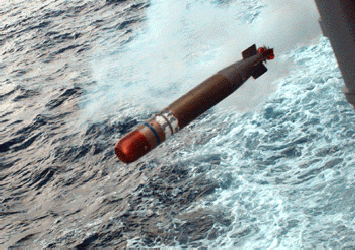|
|
|

 Description: Self-propelled guided projectile that operates
underwater and is designed to detonate on contact or in proximity to a target.
Description: Self-propelled guided projectile that operates
underwater and is designed to detonate on contact or in proximity to a target.
Features: Torpedoes may be launched from submarines,
surface ships, helicopters and fixed-wing aircraft. They are also used as parts of other
weapons; the Mark 46 torpedo becomes the warhead section of the ASROC (Anti-Submarine
ROCket) and the Captor mine uses a submerged sensor platform that releases a torpedo when
a hostile contact is detected. The three major torpedoes in the Navy inventory are the
Mark 48 heavyweight torpedo, the Mark 46 lightweight and the Mark 50 advanced lightweight.
The MK-48 is designed to combat fast, deep-diving nuclear
submarines and high performance surface ships. It is carried by all Navy submarines. The
improved version, MK-48 ADCAP, is carried by attack submarines, the Ohio class
ballistic missile submarines and will be carried by the Seawolf class attack
submarines. The MK-48 replaced both the MK-37 and MK-14 torpedoes. The MK-48 has been
operational in the U.S. Navy since 1972. MK-48 ADCAP became operational in 1988 and was
approved for full production in 1989.
The MK-46 torpedo is designed to attack high performance
submarines, and is presently identified as the NATO standard. The MK-46 Mod 5 torpedo is
the backbone of the Navy's lightweight ASW torpedo inventory and is expected to remain in
service until the year 2015.
The MK-50 is an advanced lightweight torpedo for use
against the faster, deeper-diving and more sophisticated submarines. The MK-50 can be
launched from all ASW aircraft, and from torpedo tubes aboard surface combatant ships. The
MK-50 will eventually replace the MK-46 as the fleet's lightweight torpedo.
Features: MK-48 and MK-48 ADCAP torpedoes can operate with
or without wire guidance and use active and/or passive homing. When launched they execute
programmed target search, acquisition and attack procedures. Both can conduct multiple
reattacks if they miss the target. The MK-46 torpedo is designed to be launched from
surface combatant torpedo tubes, ASROC missiles and fixed and rotary wing aircraft. In
1989, a major upgrade program began to enhance the performance of the MK-46 Mod 5 in
shallow water. Weapons incorporating these improvements are identified as Mod 5A and Mod
5A(S).
Primary Function: Heavyweight torpedo for submarines
Contractor: Gould
Power Plant: Piston engine; pump jet
Length: 19 feet (5.79 meters)
Weight: 3,434 lbs (1545.3 kg) (MK-48); 3,695 lbs (1662.75 kg) (MK-48 ADCAP)
Diameter: 21 inches (53.34 centimeters)
Range: Greater than 5 miles (8 km)
Depth: Greater than 1,200 ft (365.76 meters)
Speed: Greater than 28 knots (32.2 mph, 51.52 kph)
Guidance System: Wire guided and passive/active acoustic homing
Warhead: 650 lbs (292.5 kg) high explosive
Date Deployed: 1972
Primary Function: Air and ship-launched lightweight torpedo
Contractor: Alliant Techsystems
Power Plant: Two-speed, reciprocating external combustion; Mono-propellant (Otto
fuel II) fueled
Length: 102.36 in. tube launch configuration (from ship)
Weight: 517.65 lbs (warshot configuration)
Diameter: 12.75 inches
Range: 8,000 yards
Depth: Greater than 1,200 ft (365.76 meters)
Speed: Greater than 28 knots (32.2 mph, 51.52 kph)
Guidance System: Homing mode: Active or passive/active acoustic homing
Launch/search mode: Snake or circle search
Warhead: 98 lbs. of PBXN-103 high explosive (bulk charge)
Date Deployed: 1966 (Mod 0); 1979 (Mod 5)
Primary Function: Air and ship-launched lightweight torpedo
Contractor: Alliant Techsystems, Westinghouse
Power Plant: Stored Chemical Energy Propulsion System
Length: 112 inches
Weight: 750 pounds
Diameter: 12.75 inches
Speed: 40+ knots
Guidance System: Active/passive acoustic homing
Warhead: Approximately 100 pounds high explosive (shaped charge)
Hover Back....